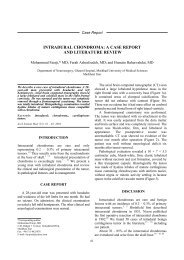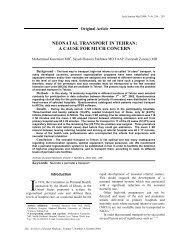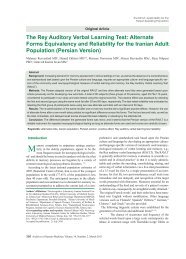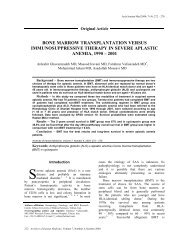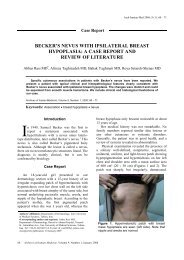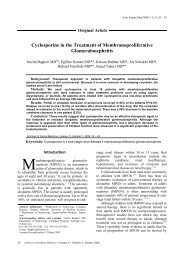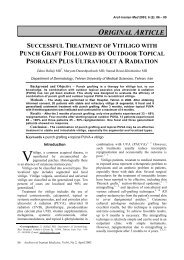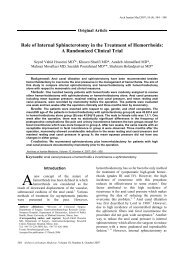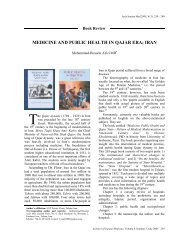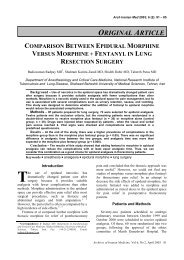PDF(174 KB)
PDF(174 KB)
PDF(174 KB)
Create successful ePaper yourself
Turn your PDF publications into a flip-book with our unique Google optimized e-Paper software.
Arch Iran Med 2009; 12 (6): 605 – 610<br />
History of Contemporary Medicine<br />
Development of Rheumatology in Tehran University<br />
of Medical Sciences<br />
Fereydoun Davatchi MD • *<br />
Abstract<br />
Rheumatology program at Tehran University was<br />
established by Fereydoun Davatchi in 1969. Later,<br />
Reza Moghtader, Firouz Panahi, and Amir-Khan<br />
Chafizadeh joined him. The first rheumatology<br />
outpatient clinic was founded in 1970. In 1974, the<br />
first rheumatology fellowship department was<br />
established along with a small research laboratory.<br />
The department expanded gradually to become the<br />
Rheumatology Research Center (RRC) in 1981. RRC<br />
was officially recognized in 1994 by the Ministry of<br />
Health and in 2001 as the Center of Excellence for<br />
Rheumatology in Iran.<br />
There are 15 rheumatologists who are the<br />
teaching staff at RRC. The center has trained up to<br />
45 rheumatologists since 1985. RRC has conducted<br />
about 150 research projects (national and<br />
international collaborative projects). It has published<br />
14 yearly books and collaborated in the publication<br />
of seven international books. RRC has presented<br />
207 papers in local and 337 papers in international<br />
conferences. RRC has published 50 papers in local<br />
and 178 papers in international journals.<br />
Keywords: Rheumatology Tehran University<br />
Introduction<br />
There are 152 Board Certified<br />
Rheumatologists in Iran. Rheumatology<br />
originated in Iran four decades ago.<br />
Until the mid sixties, rheumatology in Iran was<br />
practiced by all physicians, mainly internists,<br />
orthopedic surgeons and neurosurgeons. Among<br />
them, three names were famous in Tehran for the<br />
management of rheumatic diseases: Roubin<br />
Aftandelian, Yaghoob Mohandess, and Nosratollah<br />
Sharif. They were general practitioners who were<br />
devoted to rheumatic diseases. The era of modern<br />
Author's affiliation: *Rheumatology Research Center, Shariati<br />
Hospital, Tehran University of Medical Sciences, Tehran, Iran.<br />
•Corresponding author and reprints: Fereydoun Davatchi MD,<br />
Rheumatology Research Center, Shariati Hospital, Kargar Ave.,<br />
Tehran 14114, Iran.<br />
E-mail:fddh@davatchi.net<br />
Accepted for publication: 9 October 2008<br />
rheumatology started in Tehran in the late sixties<br />
by Saeed Bani-Hashemi, Amir-khan Chafizadeh,<br />
Fereydoun Davatchi, Eshagh Eshaghof, Reza<br />
Moghtader, Firouz Panahi, Farrokh Sarkari (who<br />
studied rheumatology in France), and Mohammad<br />
Shafizadeh (who studied rheumatology in<br />
Switzerland). A few years later, Ali-Asghar<br />
Eghtedari (1970, studied rheumatology in<br />
England), Kazem Shayan (1971, studied physical<br />
medicine and rheumatology in England), Hadi<br />
Hedayati (1974, studied rheumatology in the<br />
USA), Gholam-Ali Nasseh (1975, studied<br />
rheumatology in Switzerland and pediatric<br />
rheumatology in London), Jafar Forghanizadeh<br />
(1978, studied rheumatology in the USA), and<br />
Akbar Nahavandi (1978, who studied<br />
rheumatology in the USA) joined the<br />
rheumatology community in Iran.<br />
The Iranian Rheumatology Association (IRA)<br />
was established in 1973 under the patronage of the<br />
Iranian Medical Council. In 1978, IRA was<br />
officially recognized by the Ministry of Internal<br />
Affairs and, in 2006, by the Ministry of Health and<br />
Medical Education. The first members were: Saeed<br />
Bani-Hashemi, Amir-khan Chafizadeh,<br />
Mohammad Chafizadeh, Fereydoun Davatchi,<br />
Eshagh Eshaghof, Reza Moghtader, Firouz Panahi,<br />
Farrokh Sarkari, and Javad Vazirzadeh. At<br />
present, the Iranian Rheumatology Association has<br />
160 members.<br />
Academic rheumatology was started by<br />
Mohammad Chafizadeh at the former National<br />
University (now recognized as Shaheed Beheshti<br />
University) in 1967 and Fereydoun Davatchi at<br />
Tehran University in 1969. Soon, Reza Moghtader,<br />
Firouz Panahi, and Amir-Khan Chafizadeh joined<br />
Tehran University to form the backbone of<br />
academic rheumatology in Iran. In 1975 Kazem<br />
Shayan joined National University and Gholam-<br />
Ali Nasseh, Mashhad University. In 1978, Jafar<br />
Forghanizadeh joined Iranshahr Hospital (affiliated<br />
Archives of Iranian Medicine, Volume 12, Number 6, November 2009 605
Rheumatology in TUMS<br />
with the Imperial Medical Center of Iran which<br />
later became Iran Medical Center in 1979 and Iran<br />
University of Medical Sciences in 1983).<br />
Rheumatology in Tehran University<br />
In 1970, the first specialized rheumatology<br />
outpatient clinic was founded by Fereydoun<br />
Davatchi in former Pahlavi Hospital (now Imam<br />
Khomeini Hospital) of Tehran University. In 1974,<br />
the first rheumatology subspecialty department<br />
was created in former Daryoush Kabir Medical<br />
Center (now Shariati Medical Center), Tehran<br />
University, by Fereydoun Davatchi. The<br />
department had an inpatient ward with 16 beds,<br />
two rheumatology outpatient clinics, and a small<br />
rheumatology research laboratory. The<br />
rheumatology laboratory of Tehran University was<br />
established by two immunologists, Behrouz Nikbin<br />
with the cooperation of Nooshin Foroozanfar.<br />
Fluorescent antinuclear antibody, anti-DNA, and<br />
complement fractions C3 and C4 soon became<br />
routine tests in the rheumatology ward, were<br />
quickly adopted at Tehran Medical School, and<br />
later at other private medical laboratories. In late<br />
1974, the Connective Tissue Diseases Outpatient<br />
Clinic and in 1977 the Behcet’s Disease Outpatient<br />
Clinic were founded. These small clinics<br />
expanded to gradually become the Rheumatology<br />
Research Center (RRC) in 1981. RRC was the first<br />
research center at Tehran University of Medical<br />
Sciences (TUMS) to be officially recognized by<br />
the Ministry of Health and Medical Education in<br />
1994 and, in 2001, was pronounced as the Center<br />
of Excellence of Rheumatology in Iran.<br />
The second rheumatology ward in Tehran<br />
University was created by Firouz Panahi in former<br />
Pahlavi Hospital (now Imam Khomeini Hospital)<br />
in 1976. After the 1979 Islamic Revolution in Iran,<br />
more rheumatology wards were established by<br />
other universities such as: Hazrat Rassol Hospital,<br />
Iran University (Tehran) in 1990; Loghman<br />
Hospital, Shaheed Beheshti University (Tehran) in<br />
1991; and Hafez Hospital, Shiraz University in<br />
1970.<br />
Rheumatology for undergraduates<br />
In 1973, rheumatology was recognized as one<br />
of the eight fellowships of internal medicine. With<br />
the creation of the Rheumatology Department in<br />
Tehran University, the undergraduate program of<br />
internal medicine education was modified and<br />
1/8th of its total course (16 credits, each equal to<br />
16 teaching hours) was allocated to rheumatology<br />
(two credits, equal to 32 teaching hours). In 1983,<br />
four years after the revolution, the Medical<br />
Division of the Revolutionary Council for<br />
Education decreased the allocated time of<br />
rheumatology teaching to 20 hours in a semester.<br />
However, TUMS continued to provide<br />
undergraduates the extended rheumatology<br />
program of 32 hours. The program consisted of<br />
historical background, epidemiology,<br />
pathophysiology, clinical manifestations, clinical<br />
presentation, laboratory investigations, and the<br />
essentials of therapeutics of common<br />
rheumatology diseases. Gradually, other<br />
universities adopted the program designed by<br />
TUMS. Since 1987, RRC has increased the<br />
rheumatology course for undergraduates to 40<br />
hours.<br />
Rheumatology fellowship<br />
In 1979, Hooshang Attarian, Farhad Baygan<br />
(1980) and Mahmood Akbarian (1982) had their<br />
training courses of rheumatology in RRC. In 1985,<br />
a "National Board of Rheumatology Subspecialty"<br />
was created by the Ministry of Health and Medical<br />
Education. Fereydoun Davatchi (RRC, TUMS),<br />
Jafar Forghanizadeh (Hazrat Rassol, Iran<br />
University of Medical Sciences), Akbar Rajaee<br />
(Shiraz University of Medical Sciences), and<br />
Mohammad Shafizadeh (Shaheed Beheshti<br />
University of Medical Sciences) were the first<br />
members of the Subspecialty Board of<br />
Rheumatology. Four Iranian academic centers<br />
were recognized as qualified for rheumatology<br />
fellowship training: 1) RRC, TUMS (Tehran); 2)<br />
Shaheed Beheshti University of Medical Sciences<br />
(Tehran); 3) Iran University of Medical Sciences<br />
(Tehran); 4) Shiraz University of Medical Sciences<br />
(Shiraz). Mohammad-Reza Hatef and Farideh<br />
Ahmadi were the first rheumatologists that<br />
graduated respectively from RRC and Iran<br />
University in 1987. Mohammad-Reza Hatef, who<br />
is an affiliated member of RRC, created a<br />
rheumatology ward in Mashhad University of<br />
Medical Sciences (Mashhad), which later became<br />
another qualified center for rheumatology<br />
fellowship training. Since 1985, 45<br />
rheumatologists have been trained and graduated<br />
from RRC, TUMS. They are all affiliated with<br />
RRC. Their names and the universities they teach<br />
in are as follows: Mohammad-Reza Hatef (1987,<br />
Mashhad University), Farhad Shahram (1991,<br />
RRC), Farhad Gharibdoost (1993, RRC),<br />
Abdolhadi Nadji (1993, RRC), Karim Mowla<br />
606<br />
Archives of Iranian Medicine, Volume 12, Number 6, November 2009
F. Davatchi<br />
(1995, Ahavz University), Asghar Hadji-Abbasi<br />
(1995, Guilan University), Ahmad-Reza Jamshidi<br />
(1996, RRC), Mohammad-Hosein Farahvash<br />
(1996, Army University), Soosan Soroush (1997,<br />
Army University), Iraj Salehi-Abari (1997, RRC),<br />
Reza Najafizadeh (1997, RRC), Mohammad-<br />
Hasan Jokar (1997, Mashhad University), Maryam<br />
Moghaddasi (1998, RRC), Shahla Abolghassemi<br />
(2000, Azad Islami University), Irandokht<br />
Shenavar (2000, Guilan University), Shafieh<br />
Movasseghi (2001, RRC), Arash Mohammadpour-<br />
Shojaee (2001, Mazandaran University), Hosein<br />
Soleymani-Salehabadi (2001, Yazd University),<br />
Mohammad-Saeed Seradj (2001, Ahvaz<br />
University), Mandana Rezazadeh (2002, Kerman<br />
University), Batool Zamani (2002, Guilan<br />
University), Nooshin Bayat (2002, Baghiatollah<br />
University), Masoomeh Akhlaghi (2003, RRC),<br />
Mehrdad Aghaii (2003, Golestan University),<br />
Abdolrahman Rostamian (2003, RRC), Habib<br />
Zayeni (2003, Guilan University), Kourosh<br />
Ghaznavi (2004, Ghom University), Mehrzad Haj-<br />
Alilou (2004, Tabriz University), Farideh Samadi<br />
(2004, Azad Islami University), Mohsen Soroush<br />
(2004, Army University), Alireza Khabazi (2005,<br />
Tabriz University), Amir-Hossein Salari (2005,<br />
Isfahan University), Sakineh-Khatoon Sharif<br />
(2005, Tabriz University), Kamal Esalat-Manesh<br />
(2006, Kashan University), Mansour Karimifar<br />
(2006, Isfahan University), Mansour Salesi (2006,<br />
Isfahan University), Tahereh Faezi (2007, RRC),<br />
Masoomeh Moobedi (2007, Shar-eKord<br />
University), Mehdi Kaffashan (2007, Ahvaz<br />
University), Mojgan Rezaipoor (2008,<br />
Kermanshah University), Ali Dehghan (2008,<br />
Yazd University), and Alireza Sadeghi (2008,<br />
Zanjan University). There are a large number of<br />
guest students from other universities who attend<br />
for short periods of one to three months.<br />
Rheumatology department<br />
The Rheumatology Department of Shariati<br />
Medical Center (former Daryoush Kabir) started<br />
with Fereydoun Davatchi and Amir-Khan<br />
Chafizadeh in 1974. In 1983, Mahmood Akbarian,<br />
in 1991 Farhad Shahram, in 1993 Abdolhadi Nadji<br />
and Farhad Gharibdoost, in 1996 Ahmad-Reza<br />
Jamshidi, in 2006 Masoomeh Akhlaghi, and in<br />
2008 Tahereh Faezi joined the rheumatology staff<br />
of Shariati Hospital. In 1976, Firooz Panahi and<br />
Ali Khalvat started the Rheumatology Ward of<br />
Imam Khomeini Hospital (former Pahlavi Medical<br />
Center). In 1997 Reza Nadjafizadeh, in 2001<br />
Shafieh Movassaghi and in 2003 Abdolrahman<br />
Rostamian joined the Imam Khomeini Hospital<br />
rheumatology ward. In 1971 Reza Moghtader and<br />
in 1997 Iraj Salehi-Abari joined the Internal<br />
Medicine Department of Amir-Aalam Hospital as<br />
rheumatologists. In 1998 Maryam Moghadassi<br />
joined as a rheumatologist of the Internal Medicine<br />
Department of Sina Hospital, followed by Ahmad<br />
Salimzadeh in 2001. The RRC of TUMS with its<br />
four branches (Shariati Medical Center, Imam<br />
Khomeini Hospital, Amir-Aalam Hospital, and<br />
Sina Hospital) had 18 rheumatologists as teaching<br />
staff (Reza Moghtader left in 1978, Firouz Panahi<br />
left in 1979, and Amir-Khan Chafizadeh passed<br />
away in 1990).<br />
Output and accomplishment<br />
RRC created the first Back School in Iran in<br />
1994 to help people with low back pain understand<br />
the cause of their discomfort, its mechanism, and<br />
how to deal with their pain. The Back School has<br />
five sessions starting with anatomy, physiology,<br />
and biomechanics of the spine followed by “how to<br />
work, sit, and sleep” to put the least pressure on the<br />
spine, and finally how to exercise to strengthen the<br />
spine. With the same concern, in 1995, RRC<br />
created the Knee School for knee osteoarthritis.<br />
RRC is the earliest center for treatment of<br />
osteoporosis in Iran, since the announcement by<br />
the WHO in 1991. The first BMD machine was<br />
installed in 1993 and RRC trained the first BMD<br />
technicians. RRC helped pharmaceutical<br />
companies to formulate and produce calcium<br />
carbonate and natrium fluoride for the treatment of<br />
osteoporosis in 1994. The first seminar on<br />
osteoporosis was organized in 1995. The first book<br />
about osteoporosis (multiauthor) was written in<br />
1995. RRC held the first course on “How to<br />
Interpret Bone Densitometry” in 1995 and<br />
prepared the first normal curve of BMD in the<br />
Iranian general population (reference curve on<br />
Hologic machine) in 1996. 1 In addition, RRC<br />
conducted a randomized, double-blind control<br />
study to compare alendronate manufactured by<br />
Modava Company in Iran with alendronate<br />
produced by Medichem (Spain) Company in<br />
Europe; which revealed their equal efficacy in<br />
postmenopausal osteopenia and osteoporosis (data<br />
not yet published).<br />
In 1998, RRC and the Iranian Rheumatology<br />
Association helped to create the Bone and Joint<br />
National Committee supervised by Farhad<br />
Shahram from RRC as head of the Osteoporosis<br />
Archives of Iranian Medicine, Volume 12, Number 6, November 2009 607
Rheumatology in TUMS<br />
Subcommittee in the Ministry of Health and<br />
Medical Education. Iran officially joined the Bone<br />
and Joint Decade in 1998 (signature of the chart by<br />
the Ministry of Health and Medical Education),<br />
and Iran Rheumatology Association was the<br />
representative of the Bone and Joint Decade in Iran<br />
as supervised by Farhad Shahram (from RRC).<br />
In August 2003, RRC became a member of the<br />
"Molecular Medicine Network of Iran". In the<br />
same year, RRC established its own genetic<br />
laboratory in order to take the first steps in the field<br />
of genetics in rheumatology. Since then, RRC has<br />
participated in several international projects with<br />
Austria (Professor Eveline Irschick and Professor<br />
Michael Schirmer, Innsbruck, two projects),<br />
Australia (Professor Maureen Rischmuller,<br />
Adelaide, four projects), and Portugal (Dr. Sofia<br />
Oliveira, Lisbon, one project).<br />
RRC is the main rheumatology representative<br />
of Iran in APLAR (Asia and Pacific Area League<br />
of Associations for Rheumatology). RRC has the<br />
APLAR chairmanship of the Special Interest<br />
Group (SIG) on Behcet’s Disease with Fereydoun<br />
Davatchi, co-chairman of SIG on Osteoporosis<br />
with Farhad Shahram, co-chairman of SIG on<br />
Scleroderma with Farhad Gharibdoost, and cochairman<br />
of SIG on Systemic Lupus<br />
Erythematosus with Mahmood Akbarian. RRC has<br />
organized the following symposiums on Behcet’s<br />
Disease during the International APLAR<br />
Congresses: Bali (Indonesia) 1990, Kuala Lumpur<br />
(Malaysia) 1994, Beijing (China) 2000, and<br />
Bangkok (Thailand) 2002. Collaborative studies of<br />
the APLAR SIG on Behcet’s Disease resulted in<br />
two papers. 2–3<br />
RRC is one of the pioneers of the International<br />
Society for Behcet’s Disease (ISBD) founded in<br />
2000. Iran, via RRC, has three representatives in<br />
the Council of ISBD. The Society has organized<br />
four international conferences (2002 in Germany,<br />
2004 in Turkey, 2006 in Portugal, and 2008 in<br />
Austria). RRC has presented a total of 85 papers in<br />
these conferences: 18 papers in Germany, 22 in<br />
Turkey, 24 in Portugal and 21 in Austria. RRC has<br />
conducted an international project with the<br />
collaboration of 27 countries for the creation of the<br />
new International Criteria for Behcet’s Disease<br />
(ICBD). 4–6 These countries and their<br />
representatives were: Austria (M. Schirmer, M.<br />
Baltaci), Azerbaijan (A. Isayeva), China (Y. Dong,<br />
Z. Zhang), Egypt (S. Assaad-Khalil), France (B.<br />
Wechsler), Germany (C. Zouboulis, A. Altenburg),<br />
Greece (Ph. Kaklamani), India (A. Kumar), Iran<br />
(F. Davatchi, B. Sadeghi-Abdollahi, F. Shahram,<br />
A. Nadji, C. Chams-Davatchi, H. Shams, N. Zia'I,<br />
M. Akhlagi, A.R. Jamshidi, A.K. Haghdoost), Iraq<br />
(K. Sharquie, R. Hayani), Israel (Eldad Ben-<br />
Chetrit), Italy (I. Olivieri, C. Salvarani, N.<br />
Pipitone), Japan (Sh. Ohno, K. Namba), Jordan<br />
(W. Madanat), Libya (K. Elmuntaser), Morocco<br />
(S. Benamour), Pakistan (A. Ali), Portugal (J.<br />
Crespo, T. Tribolet, C. Vasconcelos, J. Correia, L.<br />
Carvalho, M. Bastos, M.J. Serra, C. Resende, F.<br />
Ramos, M. Rosa, V. Queirَs, J. Vedes, C. Dias, J.V.<br />
Patto, F.P. Duarte), Russia (Z. Alekberova, A.<br />
Elonakov), Saudi Arabia (A. Al-Dalaan),<br />
Singapore (C. Yew-Kuang), Spain (G. Grana- Gil),<br />
Taiwan (W.C. Chen), Thailand (A. Emvalee),<br />
Tunisia (H. Houman, I. Ben-Ghorbel, M. Sliti-<br />
Khanfir), Turkey, and the USA (K. Calamia, J.<br />
Crooks). Data collection, processing, and criteria<br />
development were done at RRC.<br />
In 2000, RRC began a series of epidemiologic<br />
studies in the framework of WHO-ILAR<br />
COPCORD (Community Oriented Program for the<br />
Control of Rheumatic Diseases). A pilot study was<br />
conducted in Tehran in October 2003 to test the<br />
feasibility of a COPCORD core questionnaire<br />
translated into Farsi and to evaluate the<br />
COPCORD teams (interviewers and<br />
rheumatologists) on field work performed in 168<br />
households and interviews with 284 subjects<br />
(random selection from five districts of Tehran). 7<br />
The main part of the “COPCORD stage 1 urban<br />
study” started on 27 th of July 2004 and ended at the<br />
end of September 2005. During the study, 4096<br />
households were visited and 10291 persons were<br />
interviewed by random selection from 22 districts<br />
of Tehran. 8–9 A rural study “WHO-ILAR<br />
COPCORD Study (stage 1, rural study) in Iran” in<br />
Tuyserkan County (Province of Hamedan) started<br />
on 3 rd of September 2006 and ended on the 14 th of<br />
September 2006. The study was conducted in five<br />
villages around Tuyserkan in 614 households and<br />
1565 interviewed persons (data not yet published).<br />
An APLAR questionnaire to recognize the risk<br />
factors of knee osteoarthritis (stage III COPCORD)<br />
was developed with the collaboration of<br />
Bangladesh, China, Indonesia, Iran (RRC), and the<br />
Philippines. Iran (RRC) and Bangladesh completed<br />
and finalized the questionnaire in 2006. A pilot<br />
study was performed to validate the questionnaire<br />
by RRC in 2006 on 30 patients. A study on 480<br />
patients with osteoarthritis and 490 controls was<br />
carried out in 2007 and the data was presented at<br />
the Asia Pacific League of Associations for<br />
608<br />
Archives of Iranian Medicine, Volume 12, Number 6, November 2009
F. Davatchi<br />
Rheumatology (APLAR) Congress in 2008. An<br />
APLAR questionnaire for the evaluation of low<br />
back pain risk factors has been under development<br />
by Bangladesh and Iran (by RRC) since 2007.<br />
Research in RRC<br />
The research units in RCC are: Ankylosing<br />
Spondylitis, Behcet’s Disease, Epidemiology,<br />
Osteoporosis, Polymyositis-Dermatomyositis,<br />
Scleroderma, and Systemic Lupus Erythematosus.<br />
Each has its own electronic registry. The largest<br />
number of patients belongs to Behcet’s disease<br />
with 6238 patients as of July 2008, and is<br />
registered and updated regularly. It is followed by<br />
the systemic lupus erythematosus registry<br />
containing 2195 patients.<br />
RRC has more than 150 complete or on-going<br />
research projects. Among them, 97 (all completed)<br />
have been approved by both the RRC Research<br />
Committee and TUMS Research Committee.<br />
Twenty-one projects have been approved by the<br />
RRC Research Committee but not yet approved by<br />
TUMS. The remaining projects were proposed<br />
(and performed) before the creation of the RRC<br />
Research Committee. They were planned and<br />
conducted by RRC members. RRC projects are<br />
divided into epidemiologic studies, clinical studies<br />
(clinical evaluation of the disease, laboratory<br />
evaluation, therapeutic evaluation, and longitudinal<br />
studies), basic science, and genetics. Twelve of<br />
these projects were international collaborative<br />
studies with Australia, Austria, China, Korea,<br />
Portugal, Russia, and the US. One of the projects<br />
was an international collaboration of 27 countries<br />
for the creation of the new ICBD.<br />
Postgraduate teaching<br />
Since 1991, RRC has organized a weekly<br />
teaching program on Tuesdays, from 8 to 12 AM.<br />
It is both a teaching program for rheumatology<br />
fellowships and a postgraduate continuous medical<br />
education (CME) for rheumatologists. Since 2006,<br />
the CME is officially recognized by the Ministry of<br />
Health and Medical Education.<br />
RRC has been organizing, since 1995, an<br />
annual (in February) seminar on one of the leading<br />
subjects of rheumatology. Fourteen seminars have<br />
been held up to 2008 including: Osteoporosis<br />
(1995), Rheumatoid Arthritis (1996), Low Back<br />
Pain (1997), Seronegative Spondylarthropathies<br />
(1998), Osteoarthritis (1999), Behcet’s Disease<br />
(2000), Soft Tissue Rheumatism (2001), Systemic<br />
Lupus Erythematosus (2002), Osteoporosis (2003),<br />
Vasculitis (2004), Metabolic Diseases of Bone and<br />
Joints (2005), Rheumatoid Arthritis (2006),<br />
Connective Tissue Diseases (2007), and Infection<br />
and Rheumatology (2008).<br />
Publication<br />
RRC has published a year book since 1995<br />
whose subject is the same as the annual seminar.<br />
The content is an extensive up-to-date and review<br />
of the subject. The book is published in Farsi. Until<br />
now fourteen books have been published:<br />
Osteoporosis (1995), Rheumatoid Arthritis (1996),<br />
Low Back Pain (1997), Seronegative<br />
Spondylarthropathies (1998), Osteoarthritis (1999),<br />
Behcet’s Disease (2000), Soft Tissue Rheumatism<br />
(2001), Systemic Lupus Erythematosus (2002),<br />
Osteoporosis (2003), Vasculitis (2004), Metabolic<br />
Diseases of Bone and Joints (2005), Rheumatoid<br />
Arthritis (2006), Connective Tissue Diseases<br />
(2007), Infection and Rheumatology (2008).<br />
RRC has published four booklets for lay<br />
people: 1) What We Must Know about Behcet’s<br />
Disease. 2) What We Must Know about<br />
Osteoporosis. 3) Sports and Osteoporosis. 4)<br />
Osteoporosis and Nutrition.<br />
RRC has collaborated in the publication of<br />
seven international books: Behcet’s Disease (1989,<br />
one article), Behcet’s Disease (1993, eight<br />
articles), Behcet’s Disease (1997, 11 articles),<br />
Textbook of Clinical Rheumatology (2000, one<br />
chapter), Behcet’s Disease (2000, 25 articles),<br />
Adamanthiades-Behcet’s Disease (2002, 18<br />
articles), and Immunology of Behcet’s Disease<br />
(2003, one chapter).<br />
RRC has participated and presented 207 papers<br />
in national conferences, seminars, and congresses<br />
and 337 papers in international ones. RRC has<br />
published 50 and 178 papers in local and<br />
international medical journals, respectively.<br />
References<br />
1 Akbarian M, Davatchi F, Salimzadeh A, Shahram F,<br />
Gharibdoust F, Nadji A. Bone mass density in normal<br />
population of Iran. APLAR J Rheumatol. 2005; 8:<br />
177 – 183.<br />
2 APLAR Subcommittee for Behcet’s Disease. APLAR<br />
evaluation of Behcet’s Disease diagnosis criteria. APLAR<br />
J Rheumatol. 1998; 1: 237 – 240.<br />
3 Davatchi F, Shahram F, Kumar A, Cheng YK, Cheong<br />
CT, Bendrups A. Comparative analysis of Behcet’s<br />
Disease in the APLAR region. APLAR J Rheumatol. 2004;<br />
7: 38 – 43.<br />
4 International Study Group for the Revision of the<br />
International Criteria for Behcet’s Disease (ITR-ICBD).<br />
Evaluation of the International Criteria for Behcet’s<br />
Archives of Iranian Medicine, Volume 12, Number 6, November 2009 609
Rheumatology in TUMS<br />
Disease (ICBD). 12th International Conference on<br />
Behcet’s Disease. Clinical and Experimental<br />
Rheumatology. 2006; 24 (suppl 42): S13.<br />
5 International Study Group for the Revision of the<br />
International Criteria for Behcet’s Disease (ITR-ICBD).<br />
Revision of the International Criteria for Behcet’s Disease<br />
(ICBD). 12 th International Conference on Behcet’s<br />
Disease. Clin Exp Rheumatol. 2006; 24 (suppl 42): S14.<br />
6 Zouboulis Ch. Adamanthiades-Behcet’s Disease. In Wolff<br />
K, Goldsmith L, Katz S, et al. eds. Fitzpatrick’s<br />
Dermatology in General Medicine. 7th ed. New York:<br />
McGraw-Hill; 2008: 1620 – 1626.<br />
7 Davatchi F, Jamshidi AR, Tehrani-Banihashemi A,<br />
Darmawan J. WHO-ILAR COPCORD pilot study in<br />
Tehran, Iran. J Rheumatol. 2006; 33: 1714.<br />
8 Davatchi F, Jamshidi AR, Banihashemi AT, Gholami J,<br />
Forouzanfar MH, Akhlaghi M, et al. WHO-ILAR<br />
COPCORD study (stage 1, urban study) in Iran.<br />
J Rheumatol. 2008; 35: 1384 – 1390.<br />
9 Jamshidi AR, Tehrani-Banihashemi A, Dahaghin S,<br />
Gholami J, Froozanfar MH, Akhlaghi M, et al. Clinical<br />
Hand Osteoarthritis in Tehran: Prevalence, Signs,<br />
Symptoms, and Pattern - COPCORD Stage I, Iran Study.<br />
J Rheumatol. 2008; 35: 1467 – 1468.<br />
610<br />
Archives of Iranian Medicine, Volume 12, Number 6, November 2009



